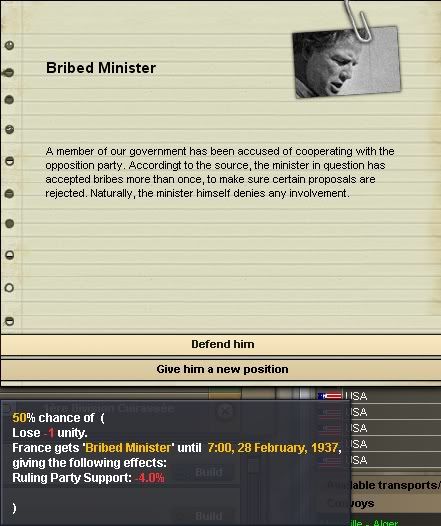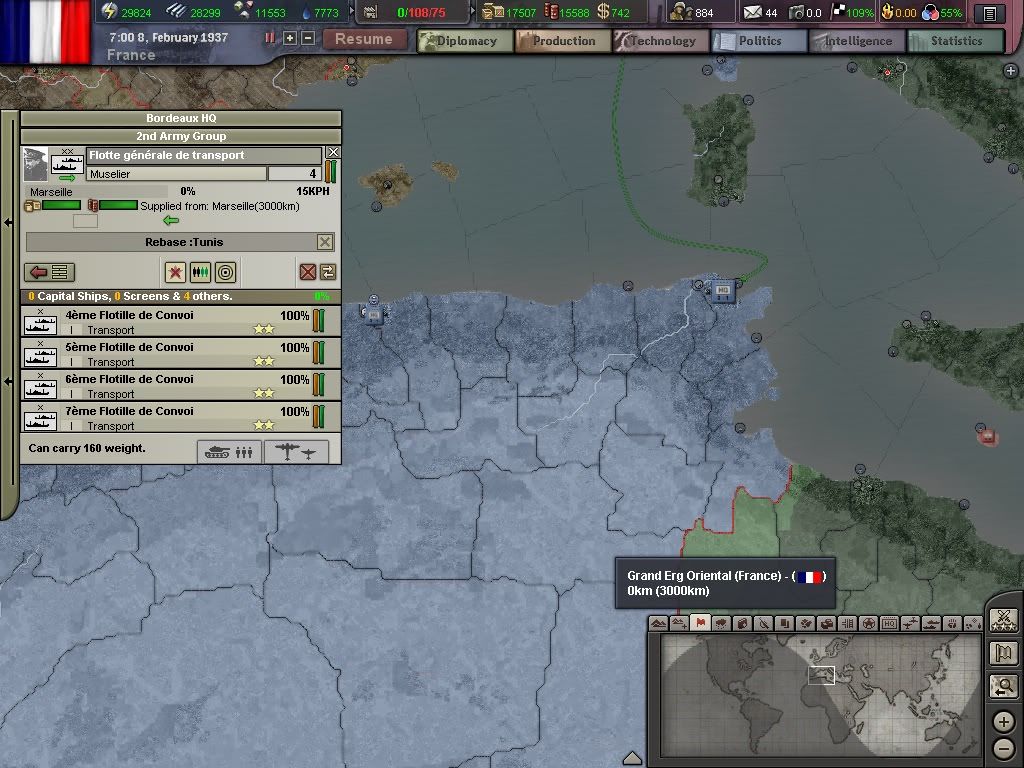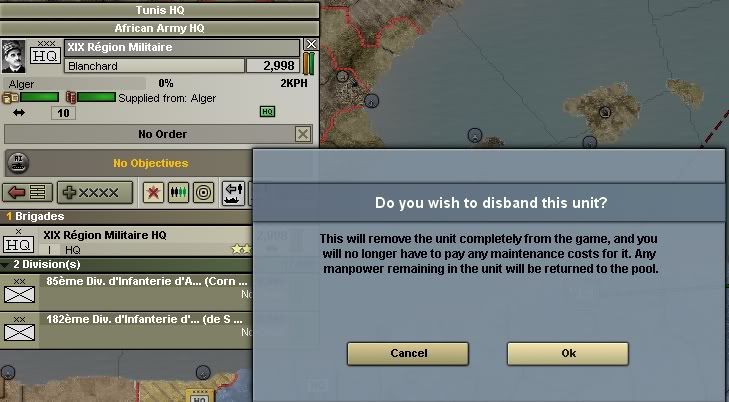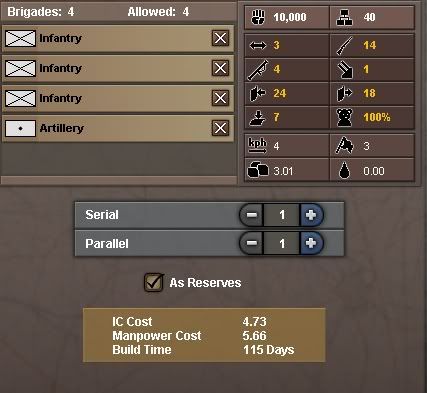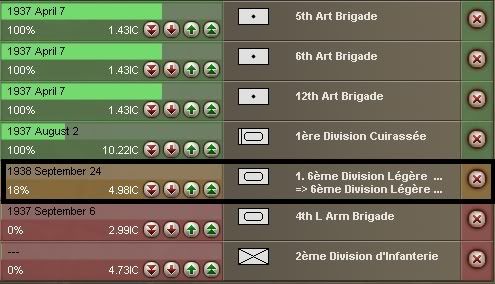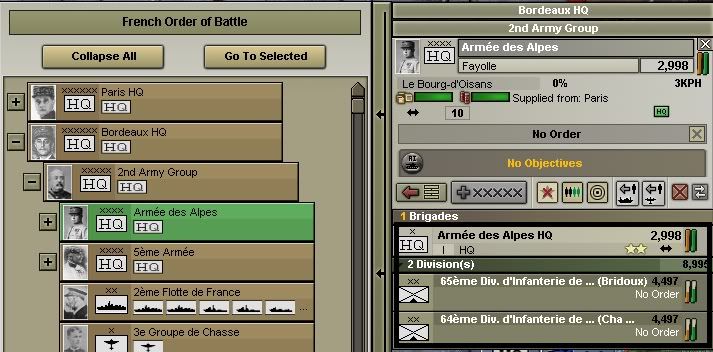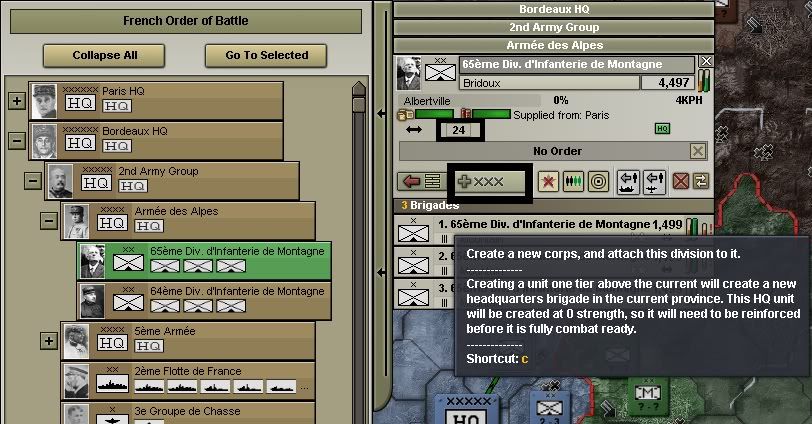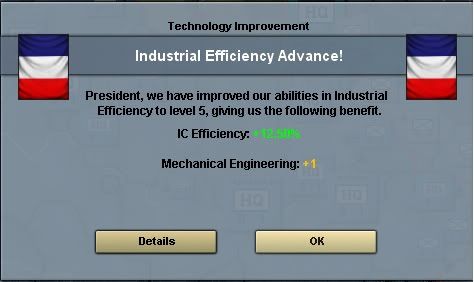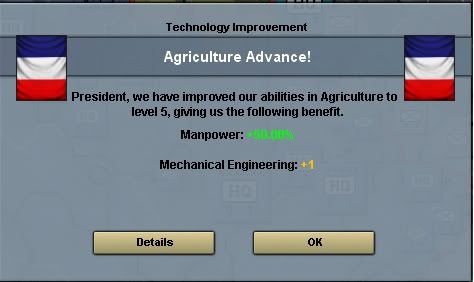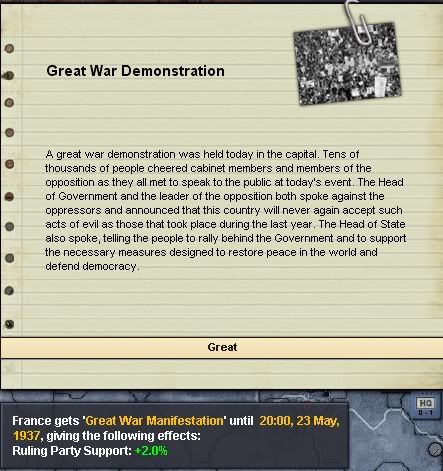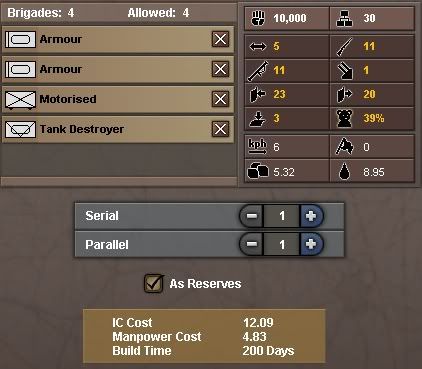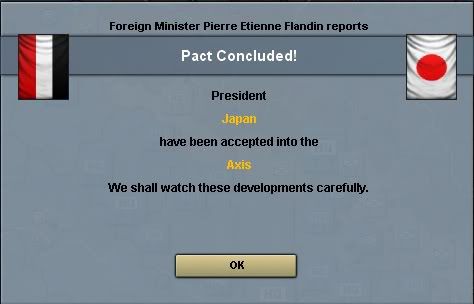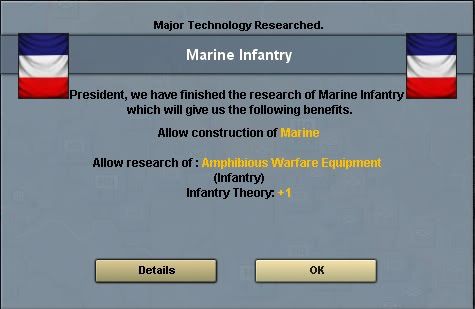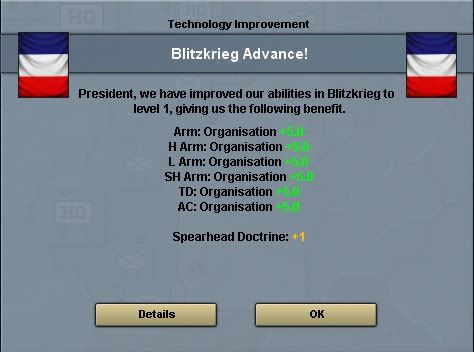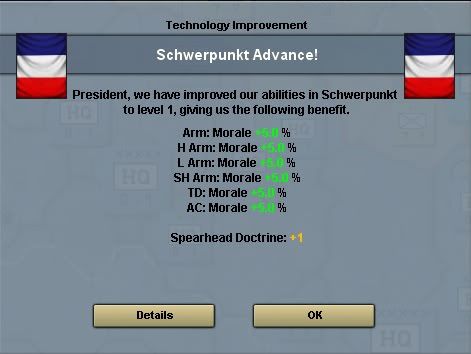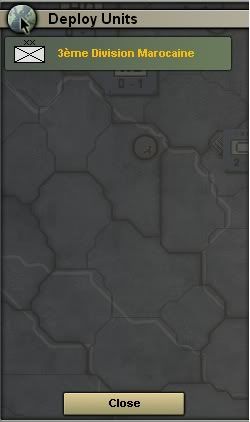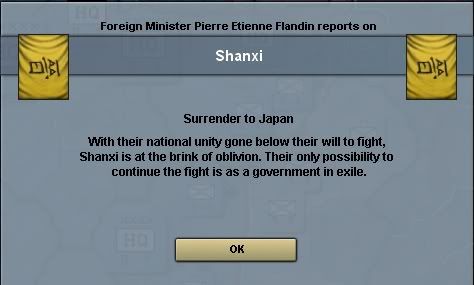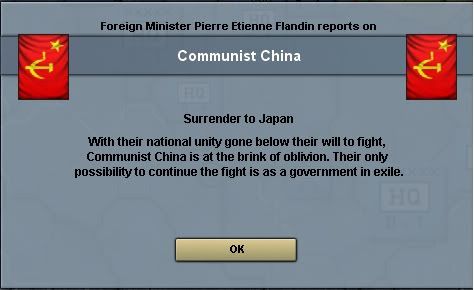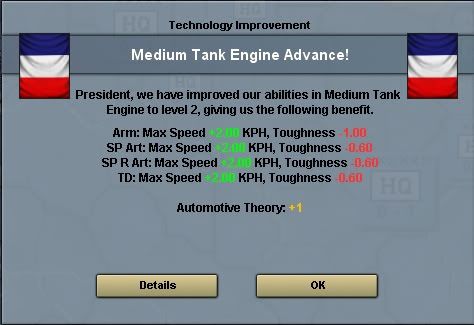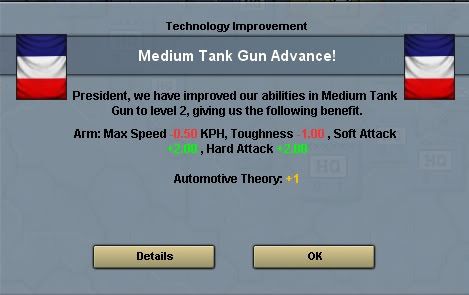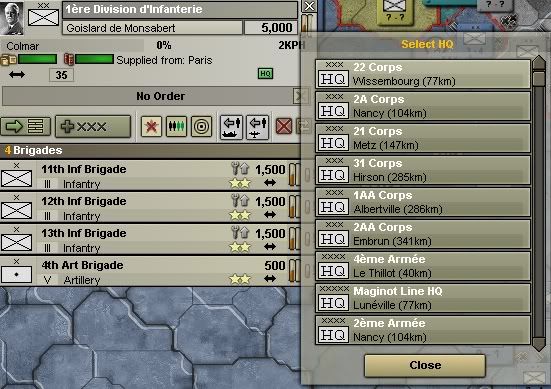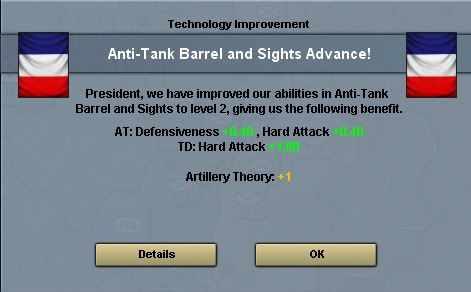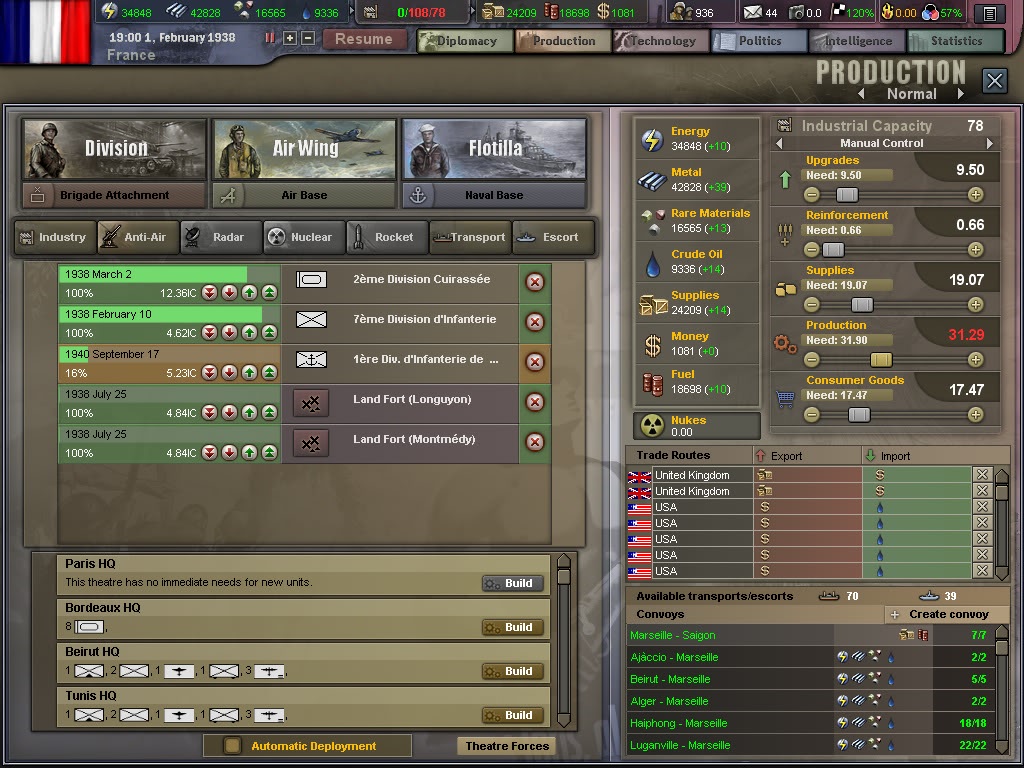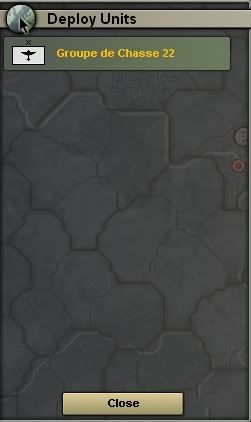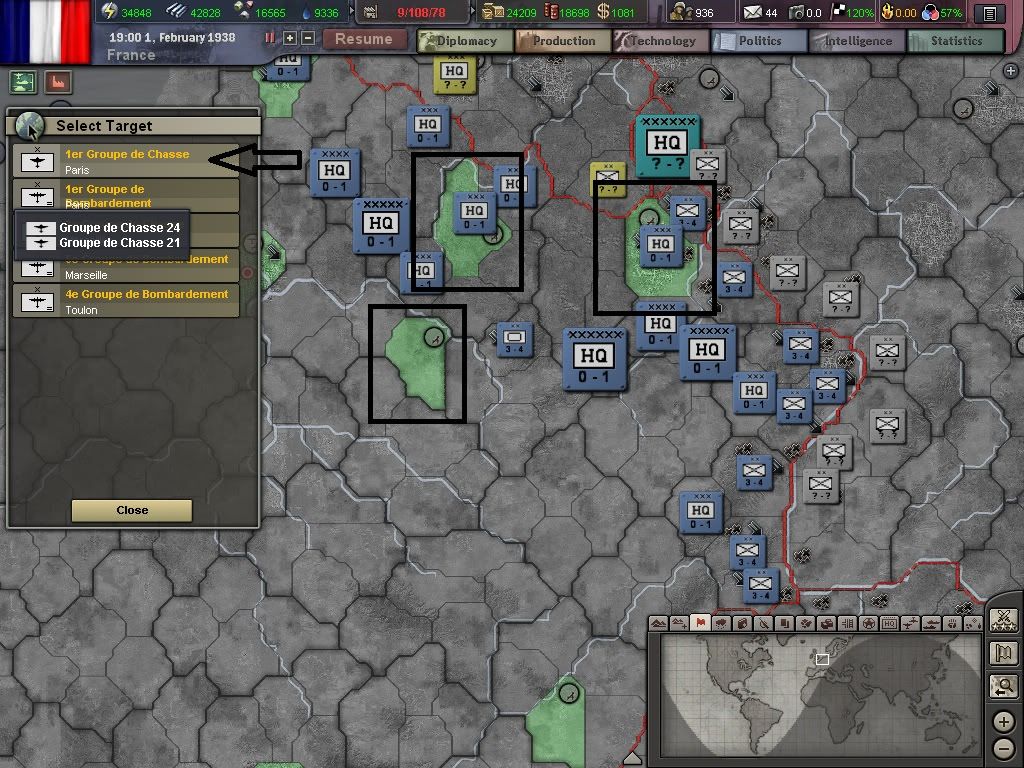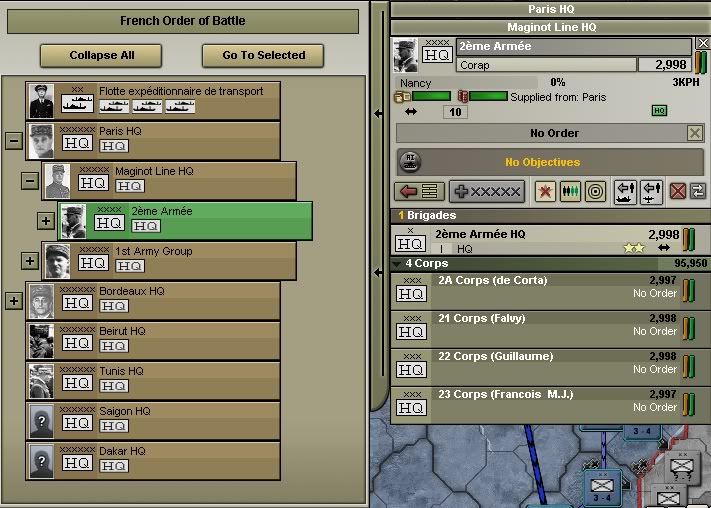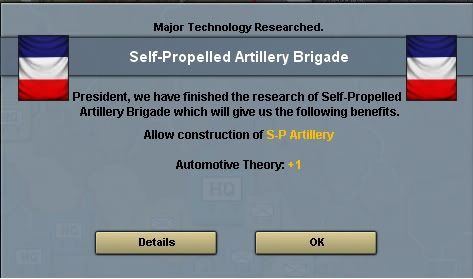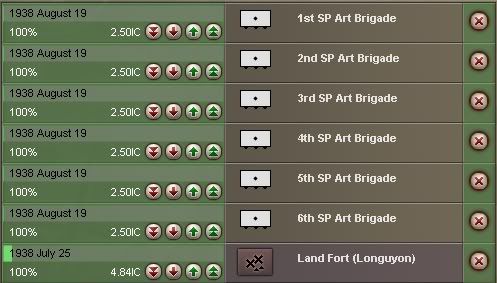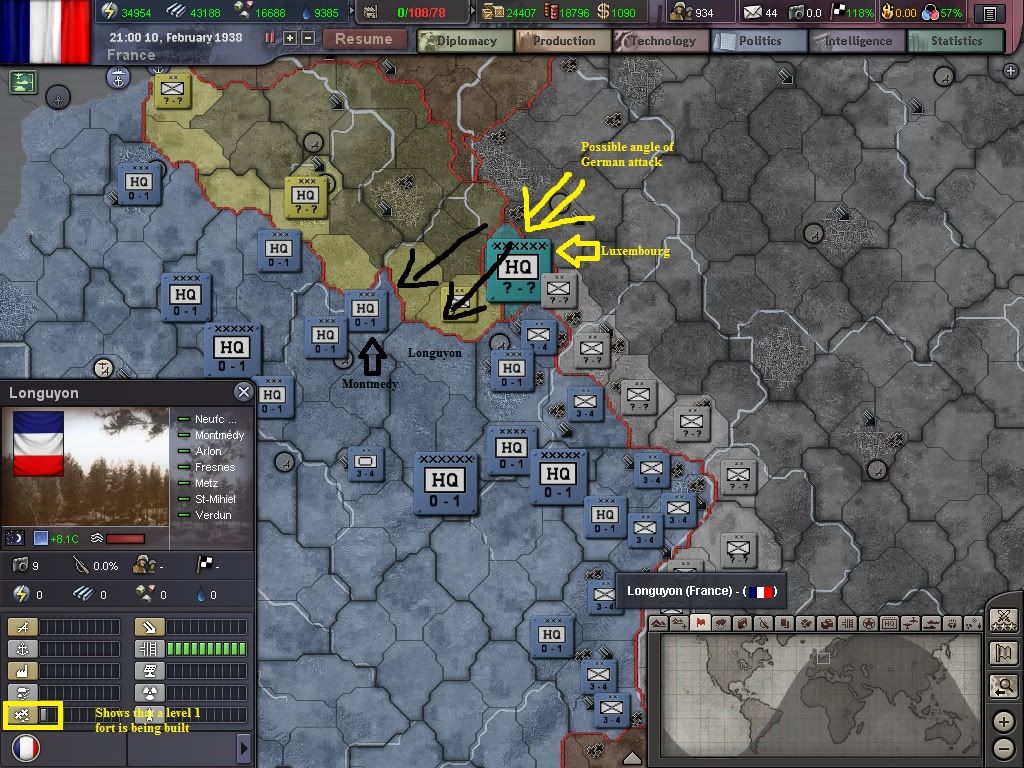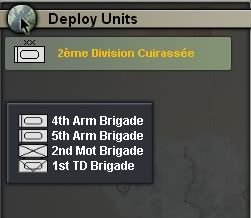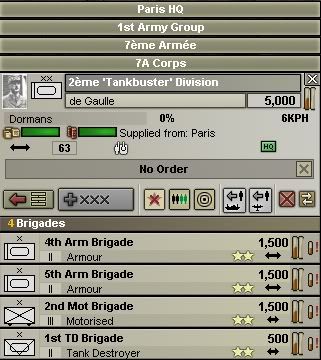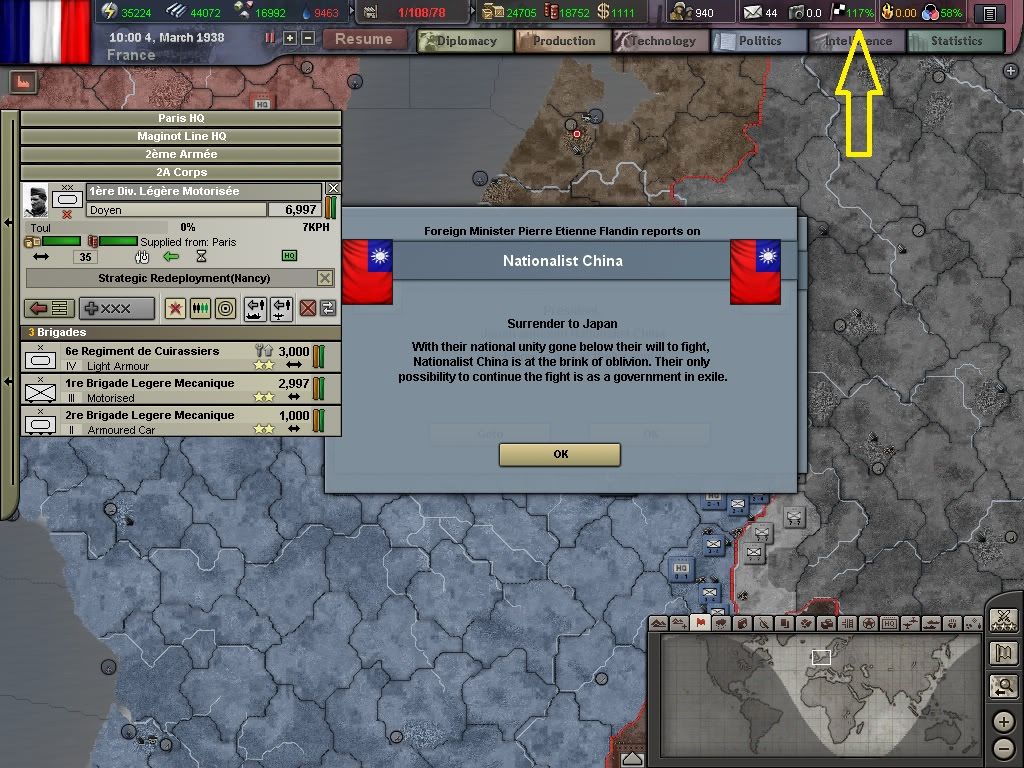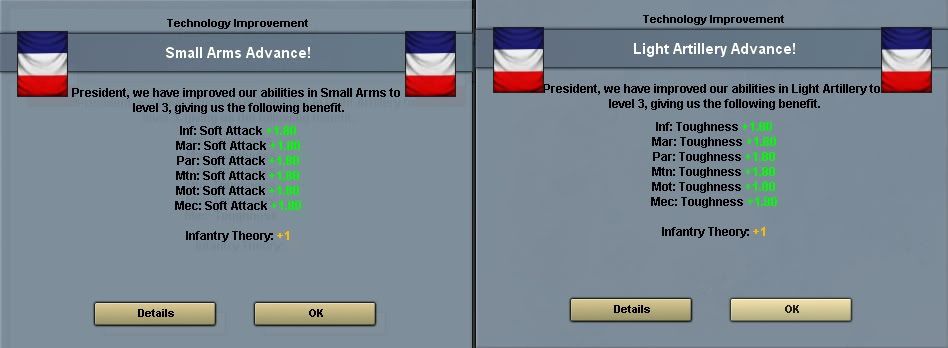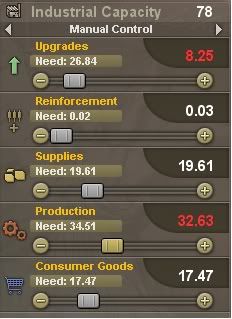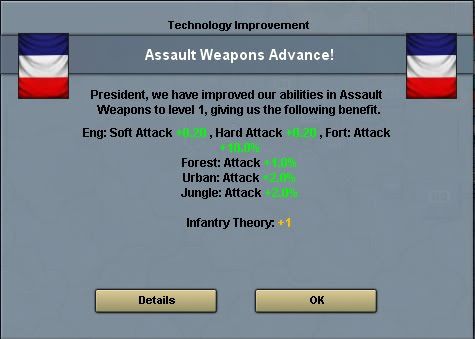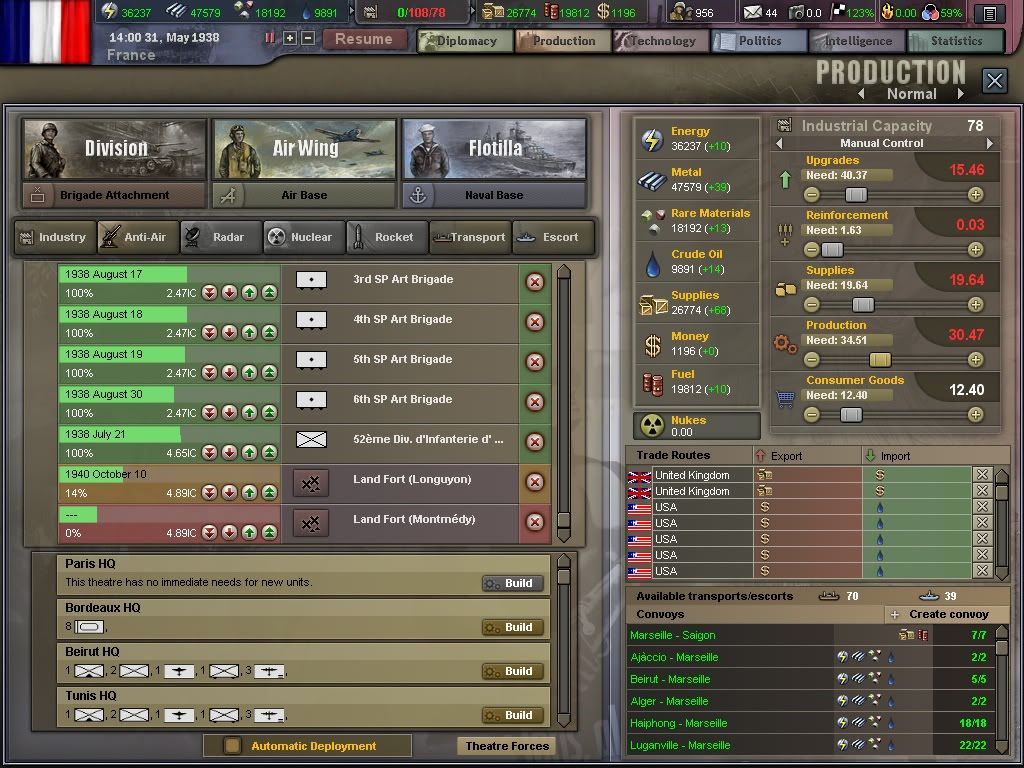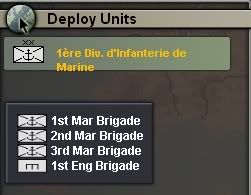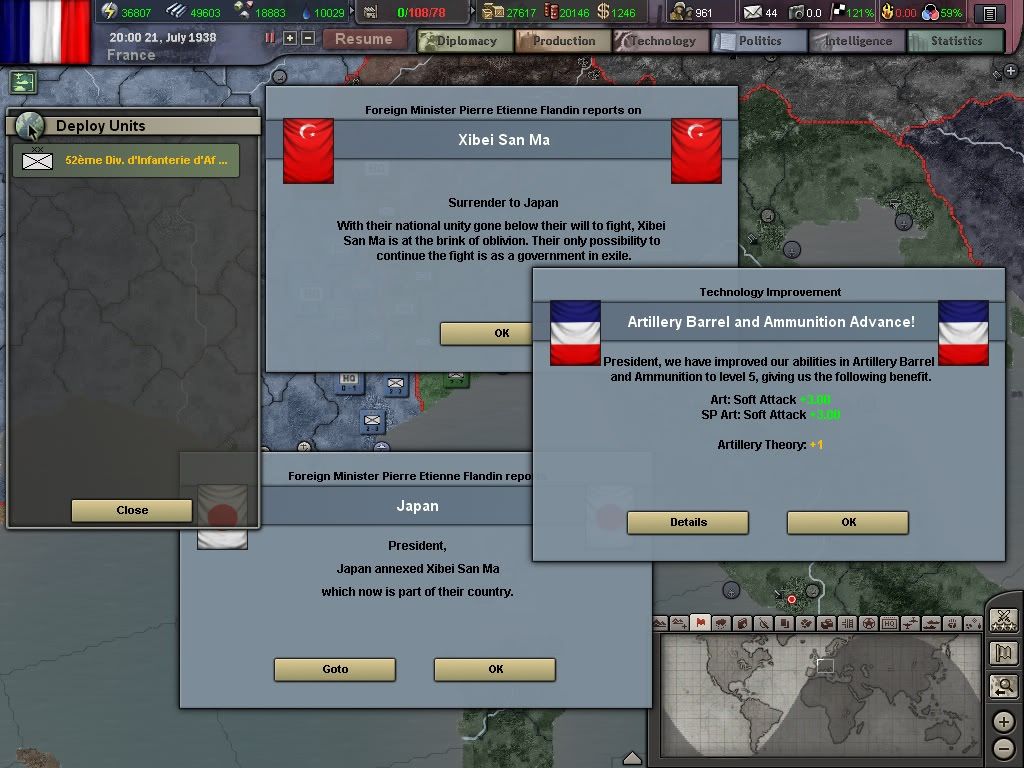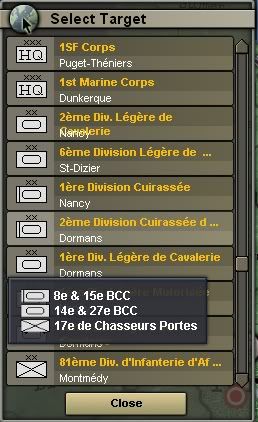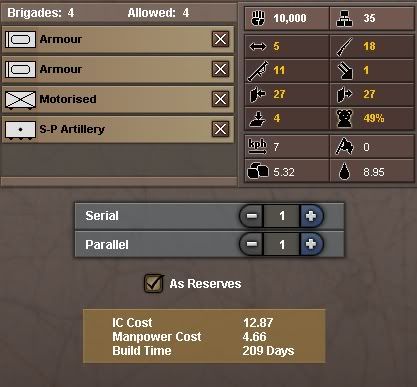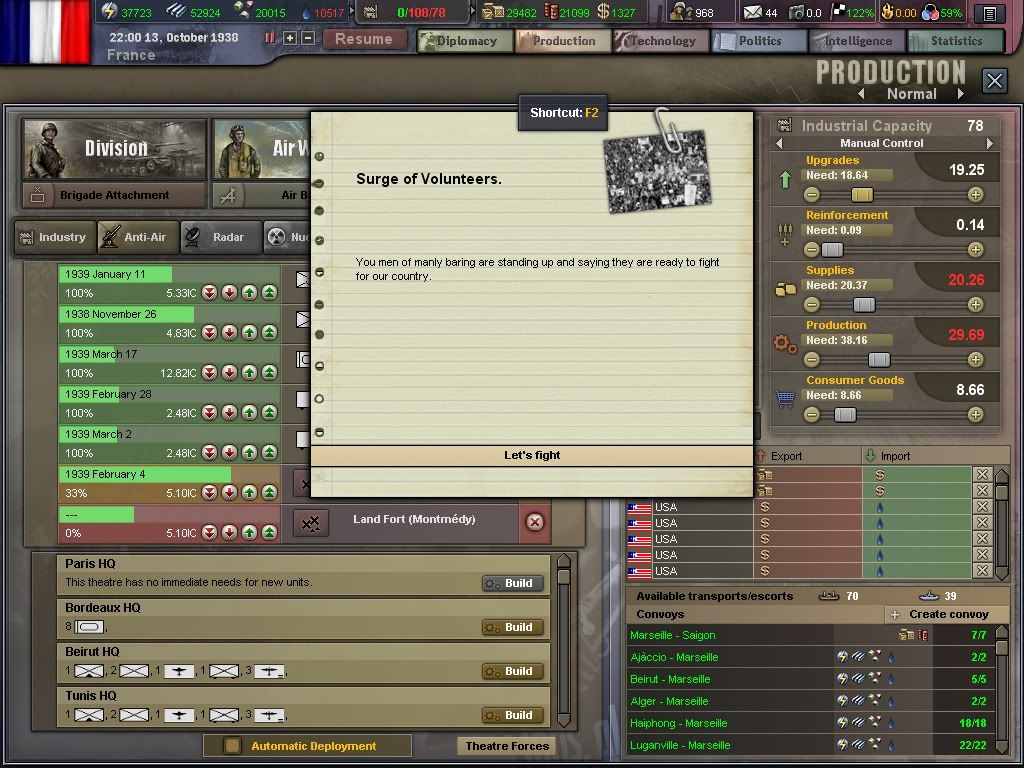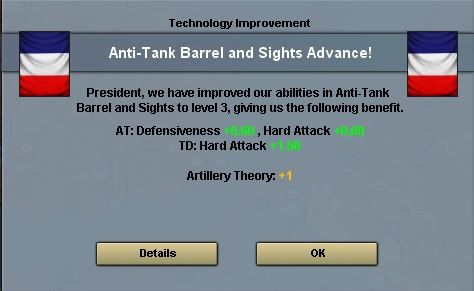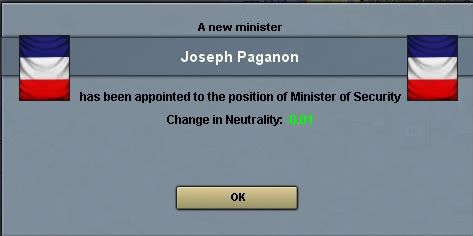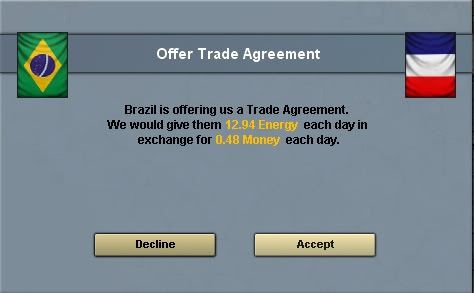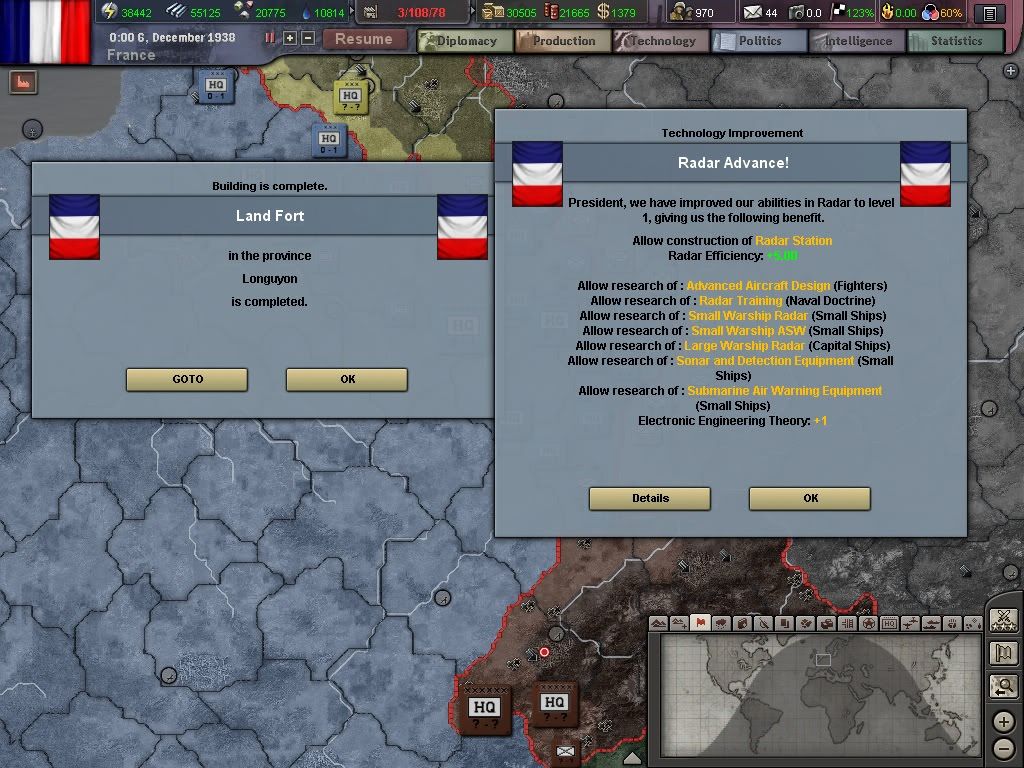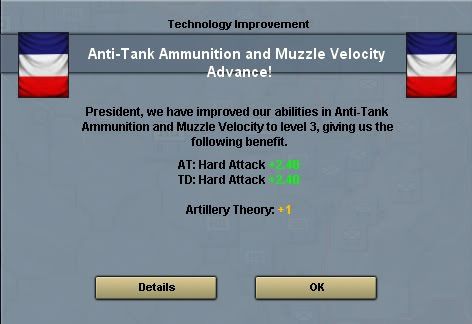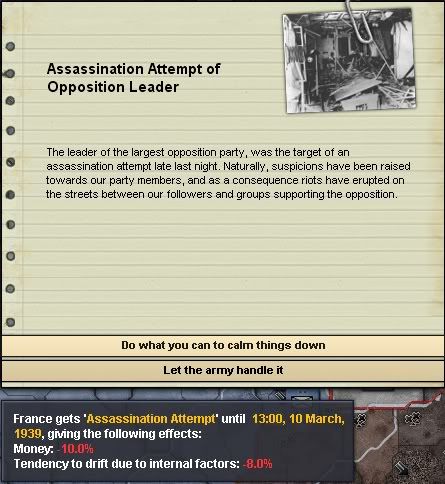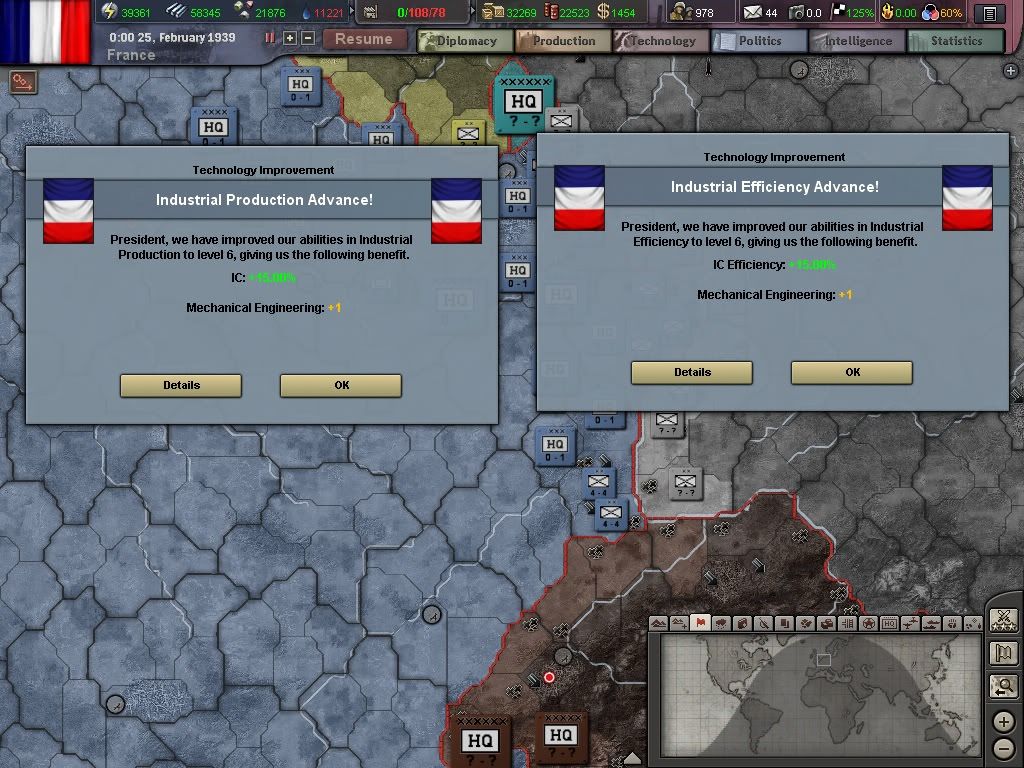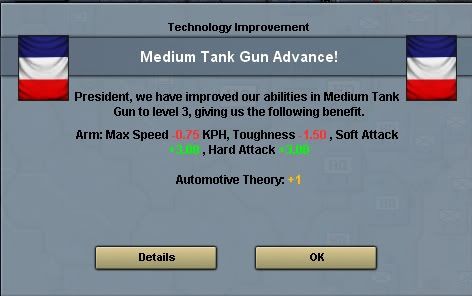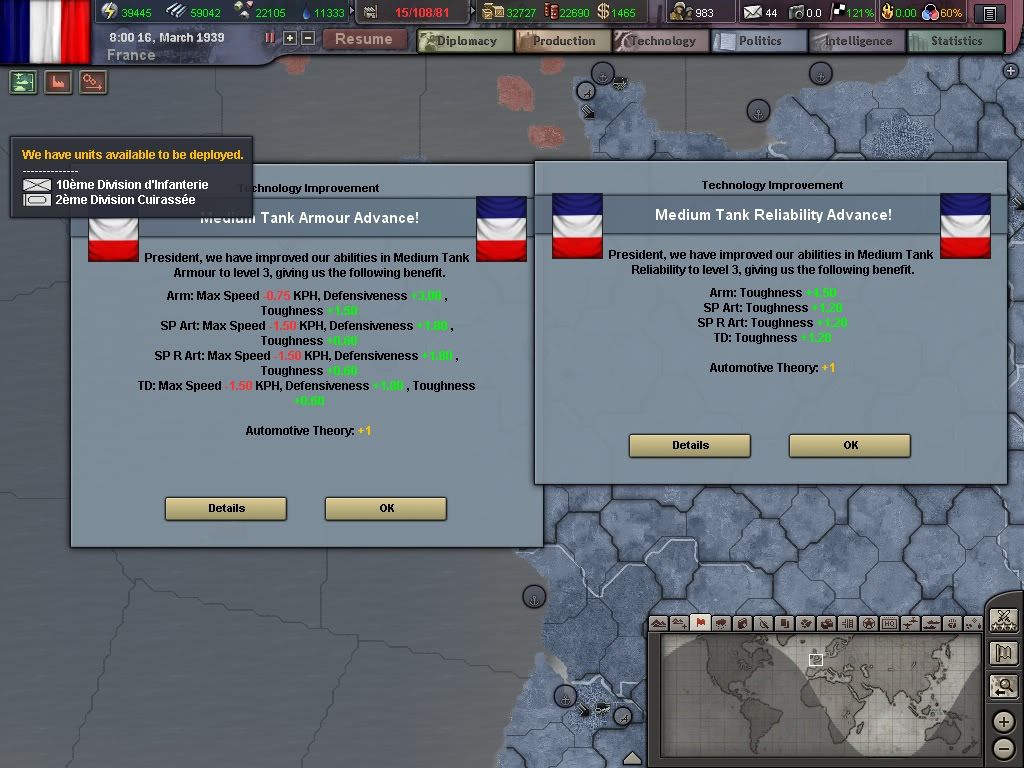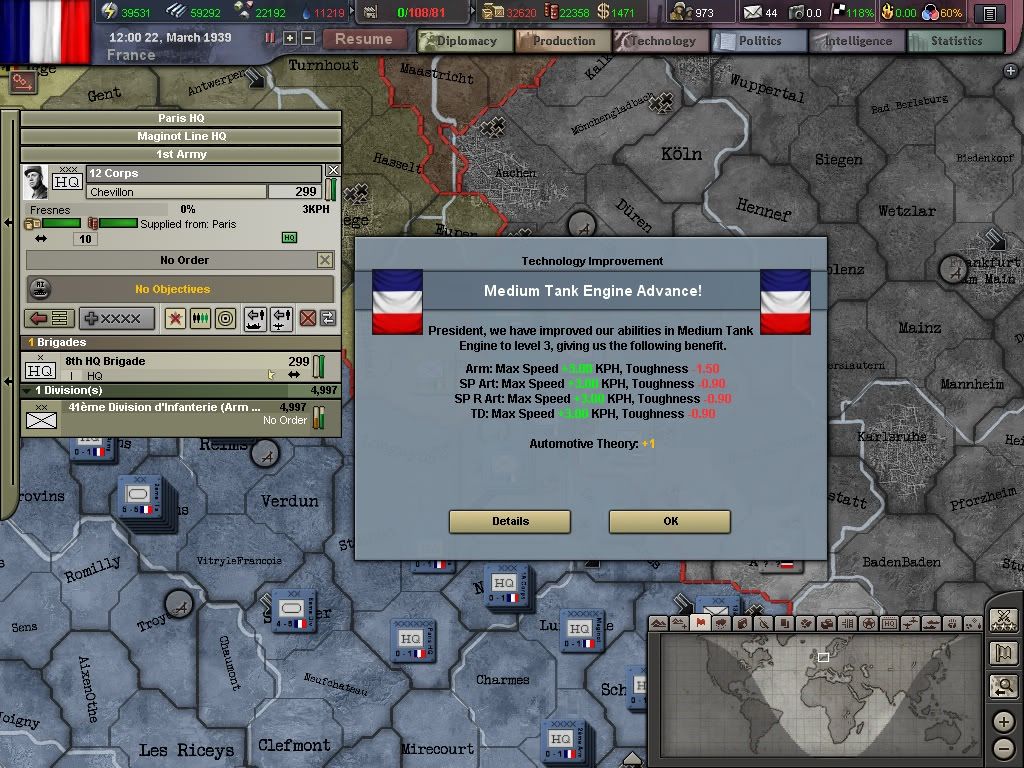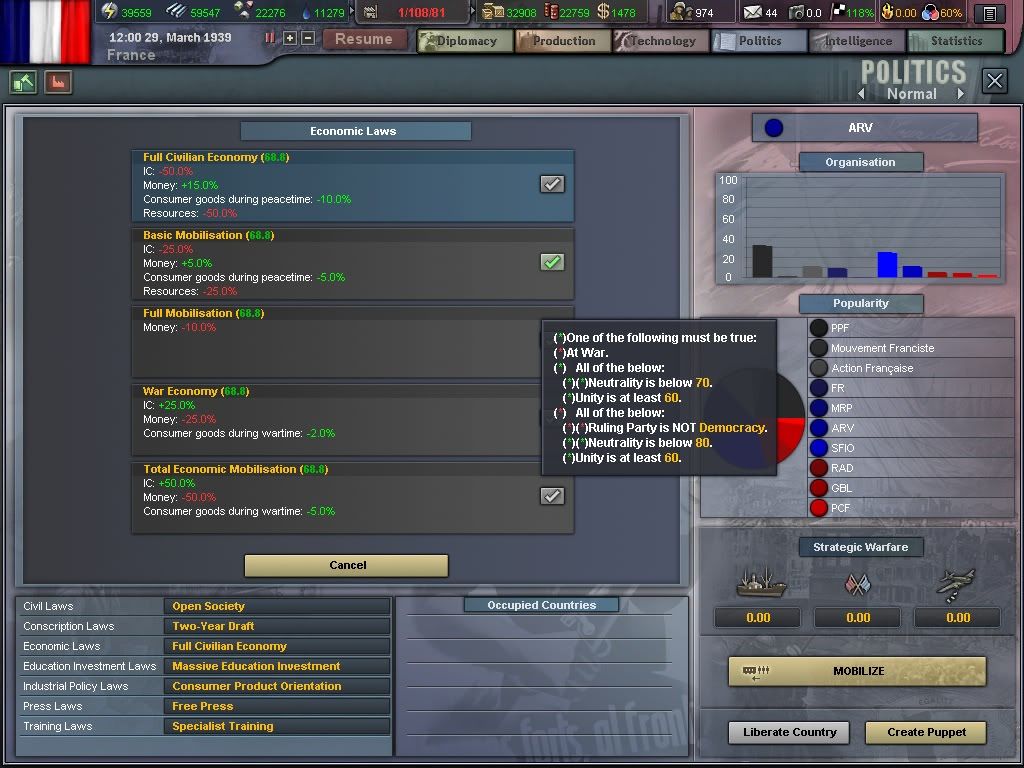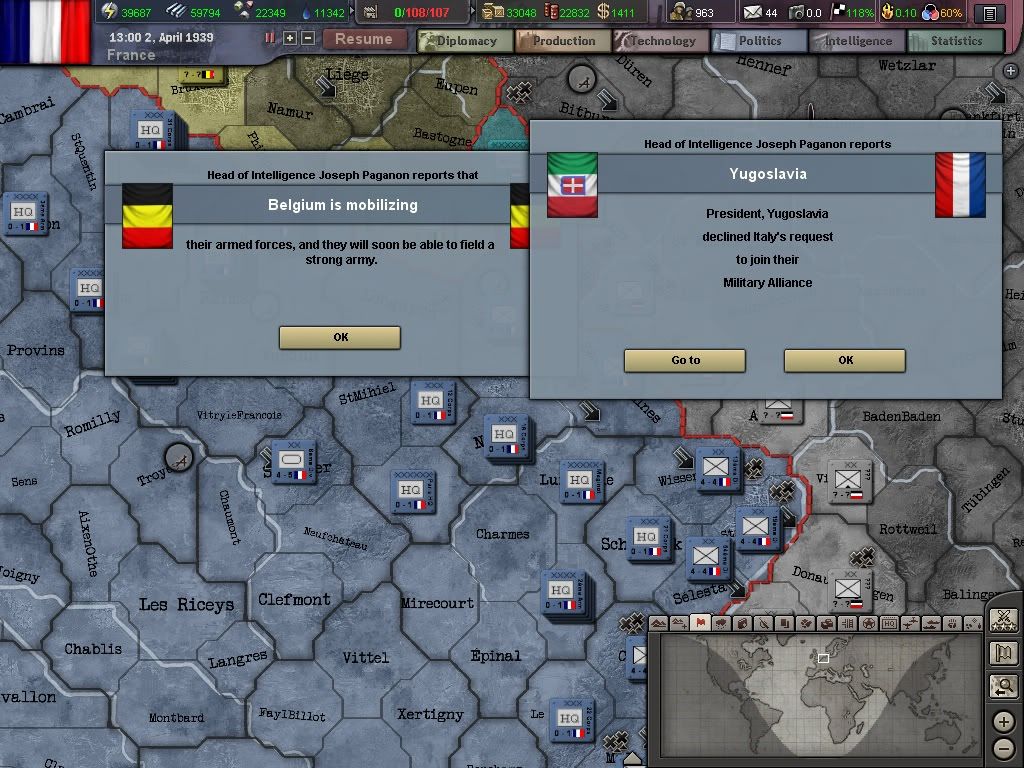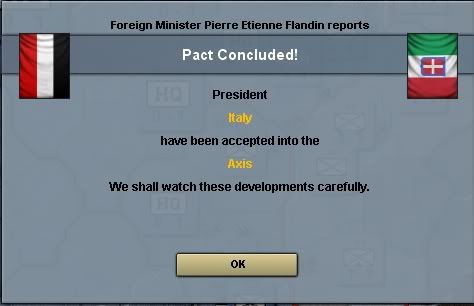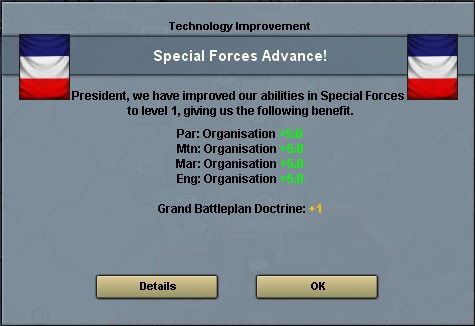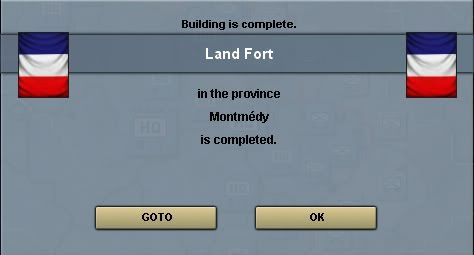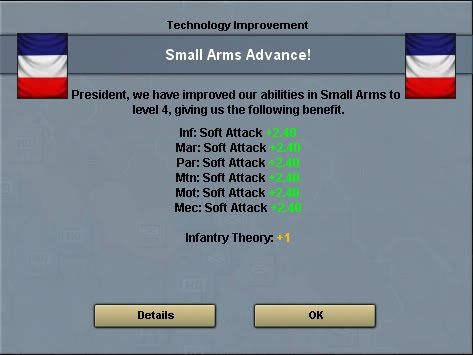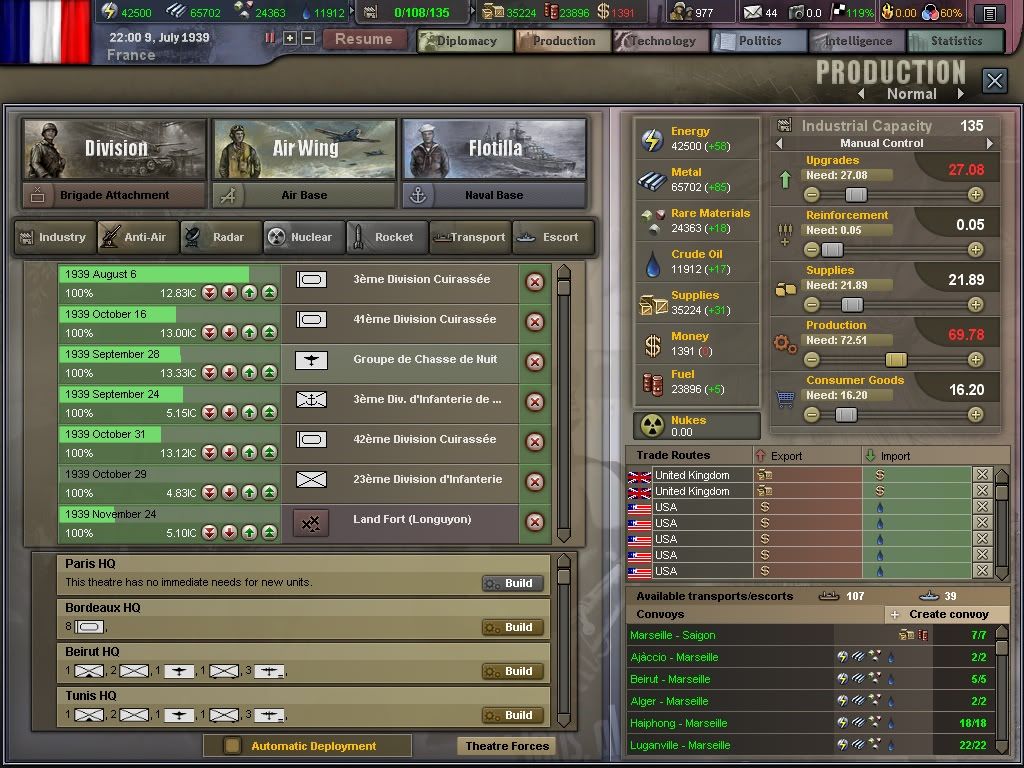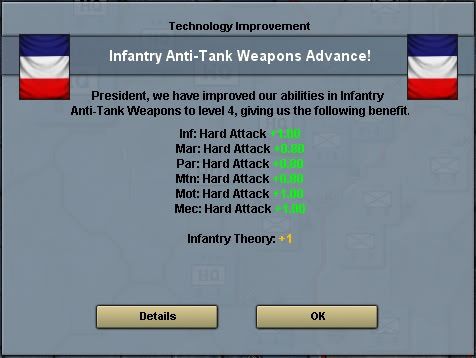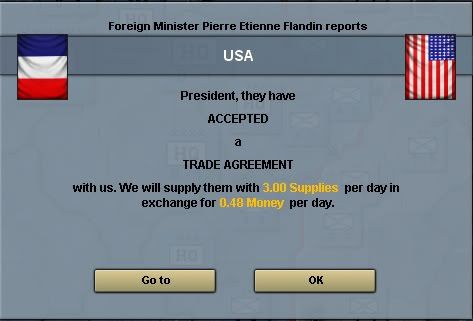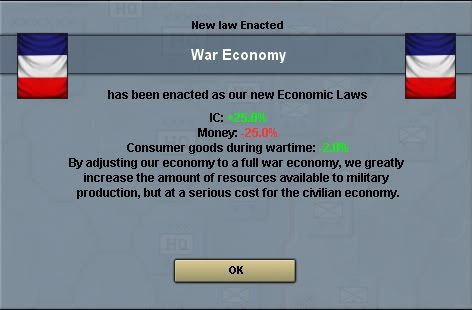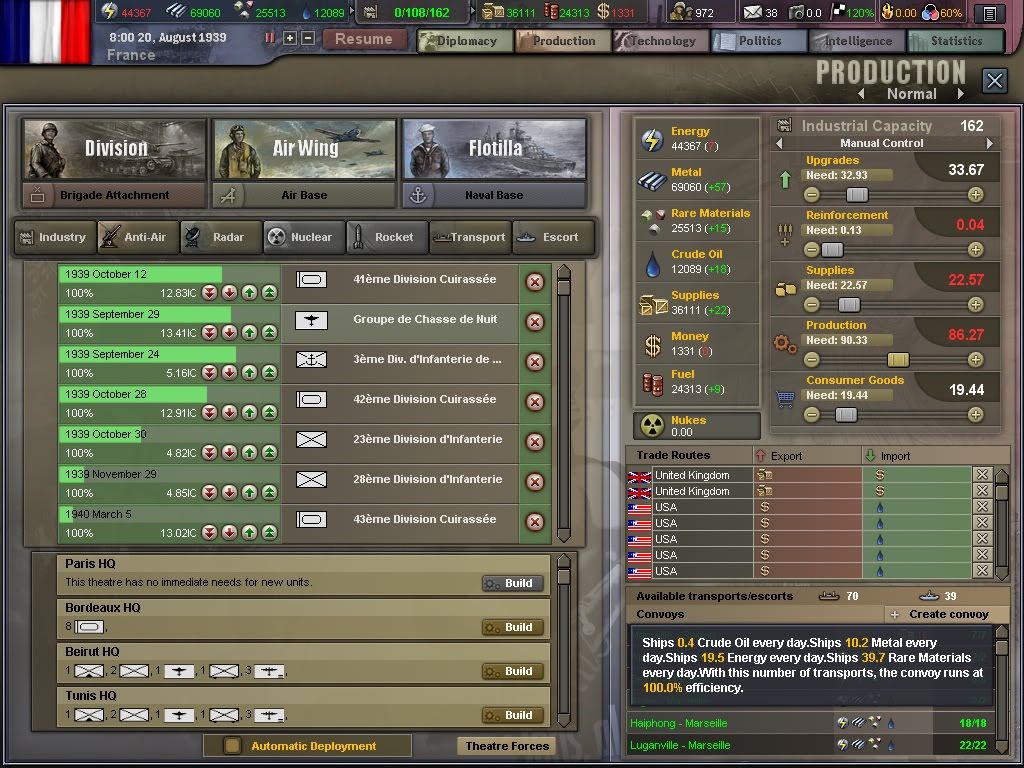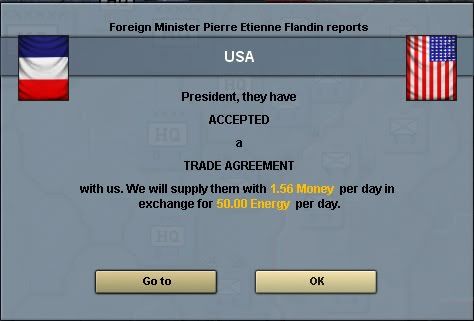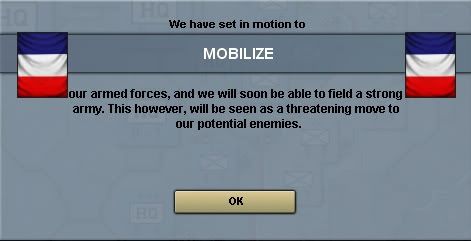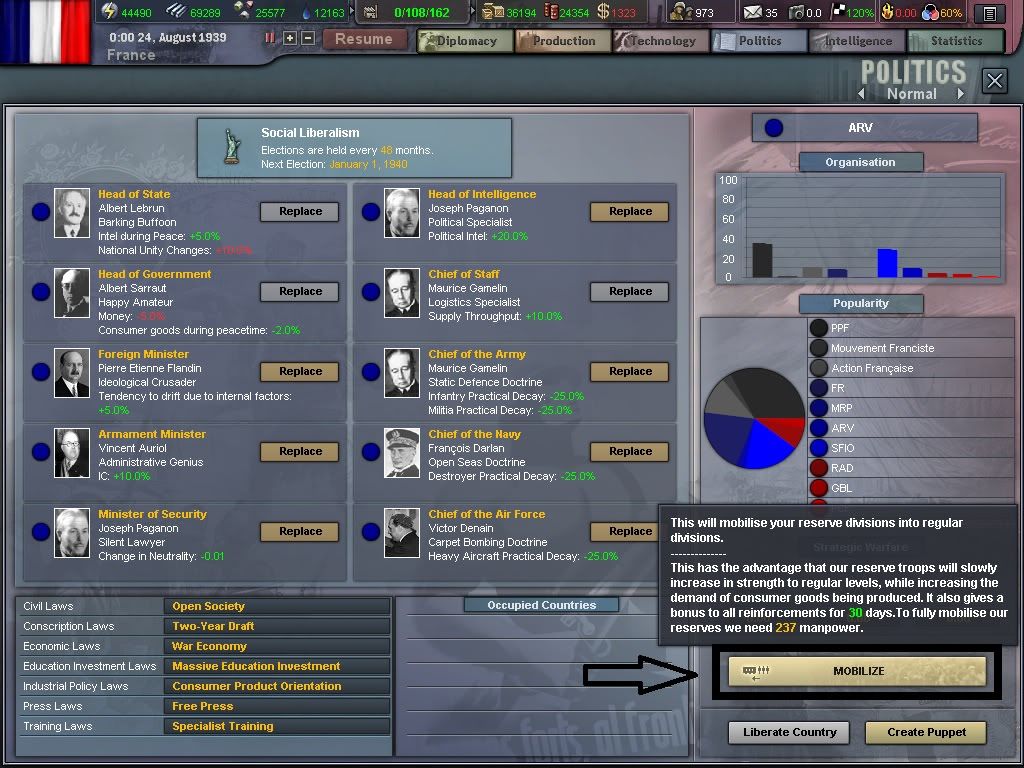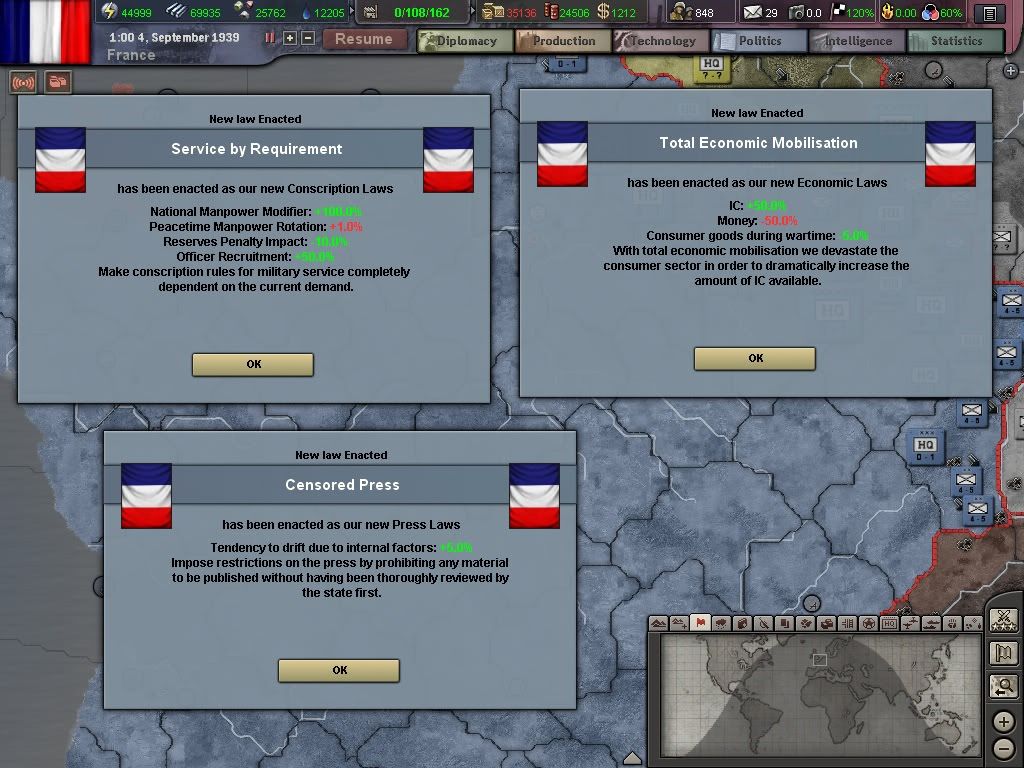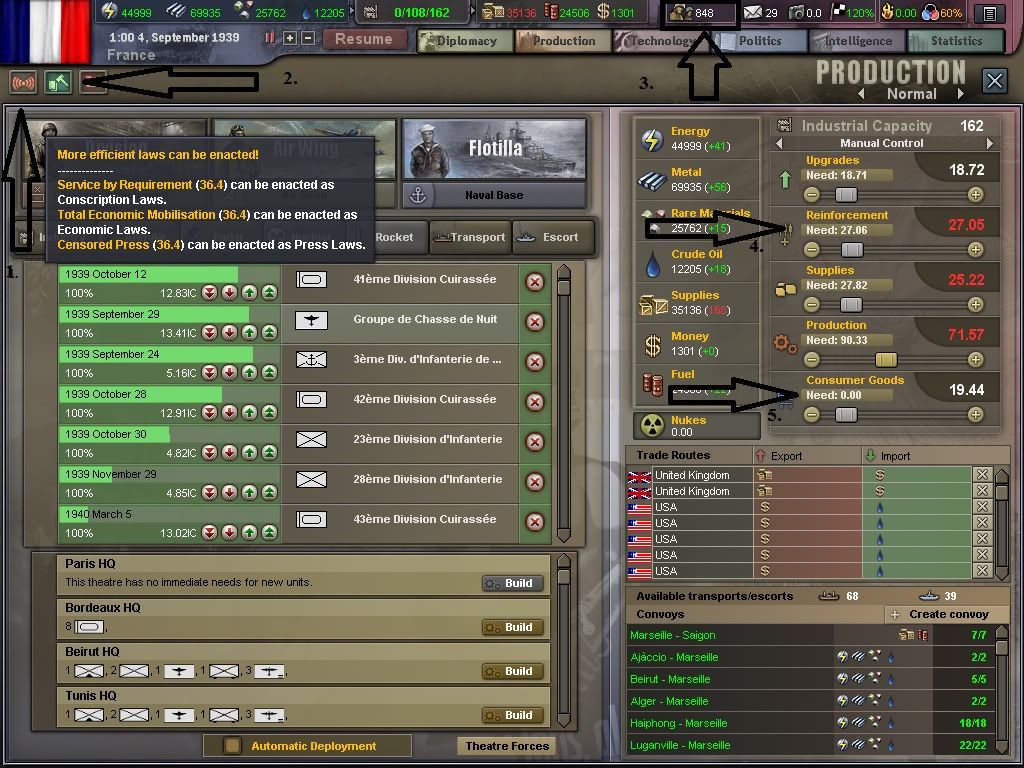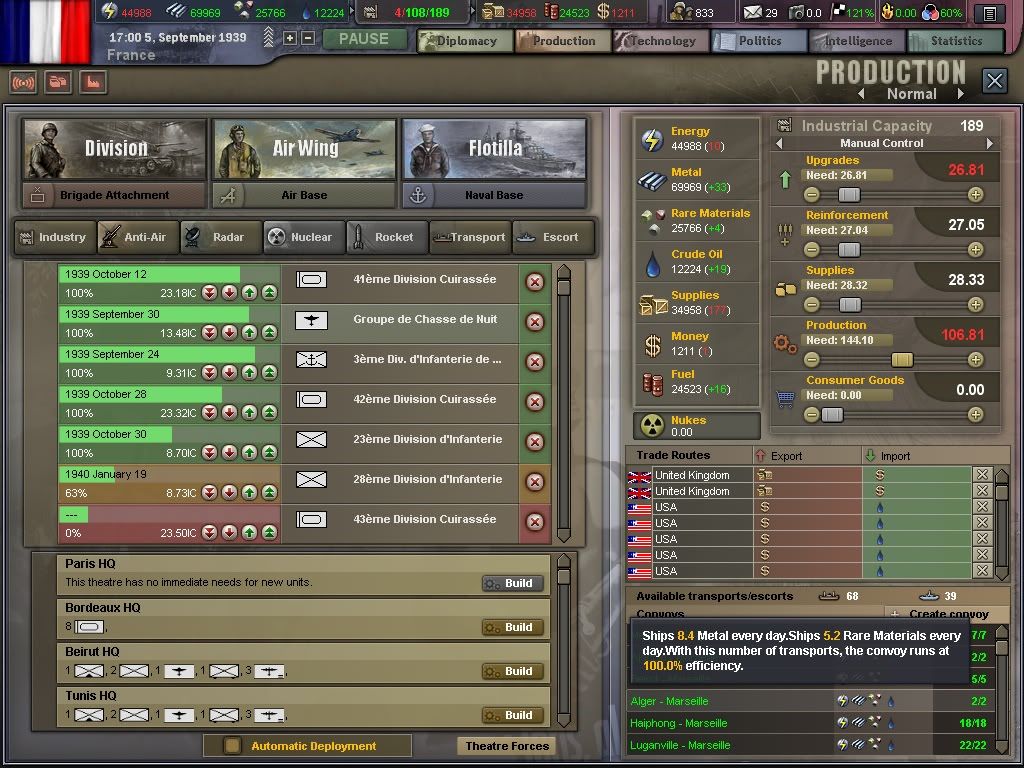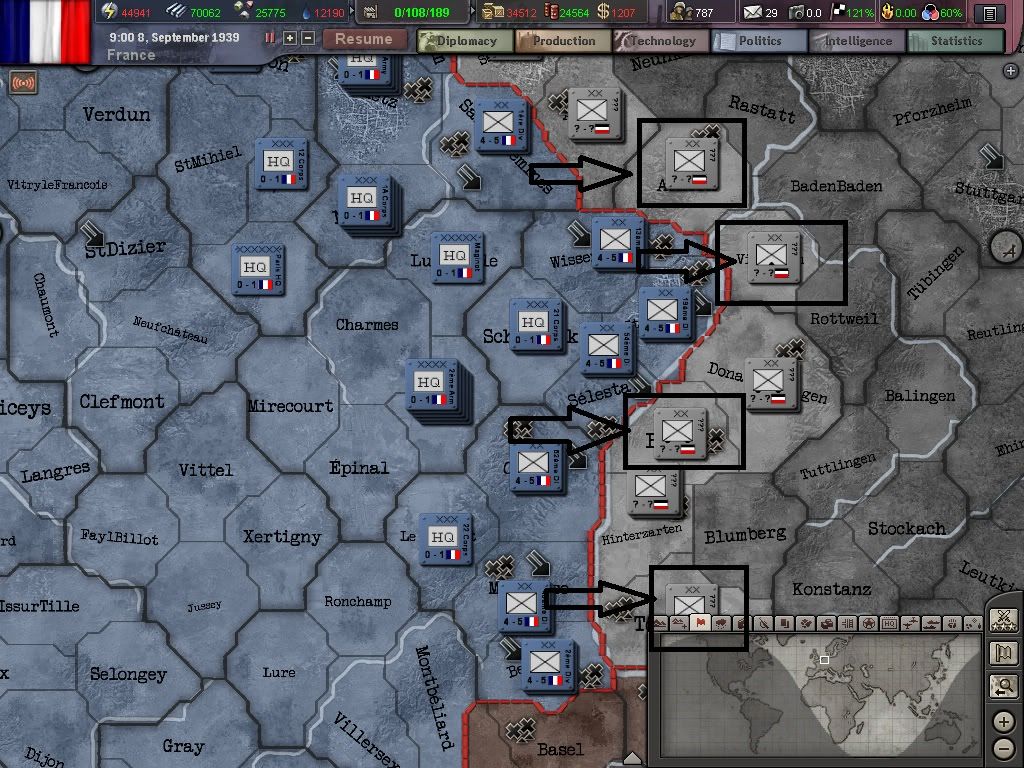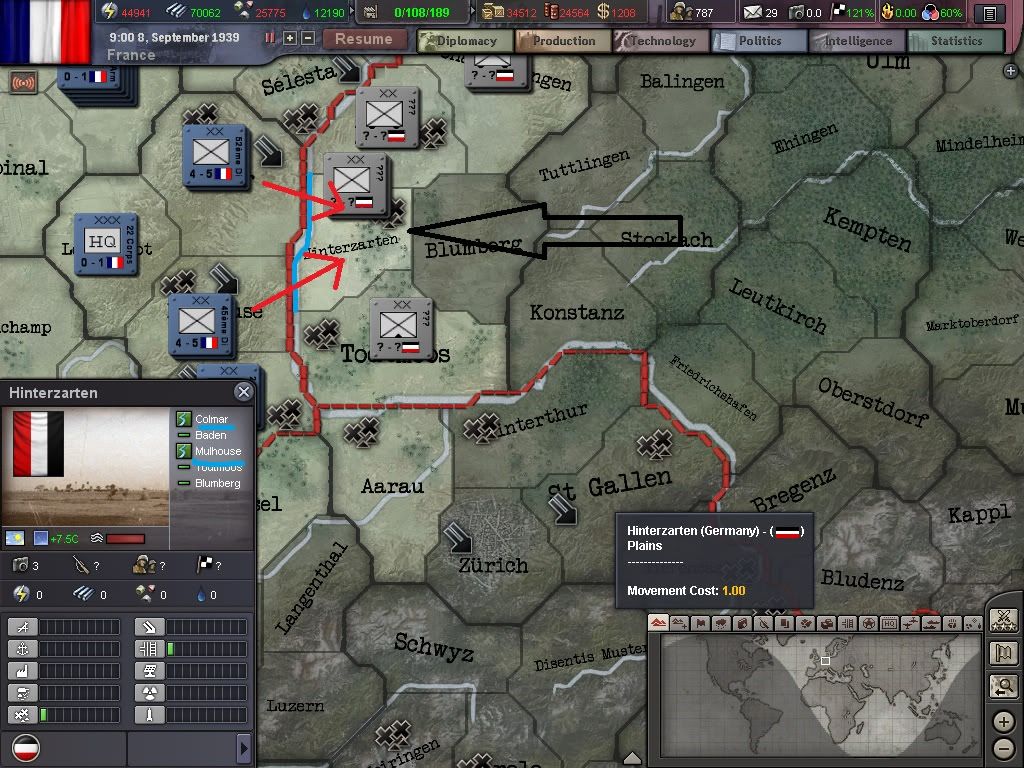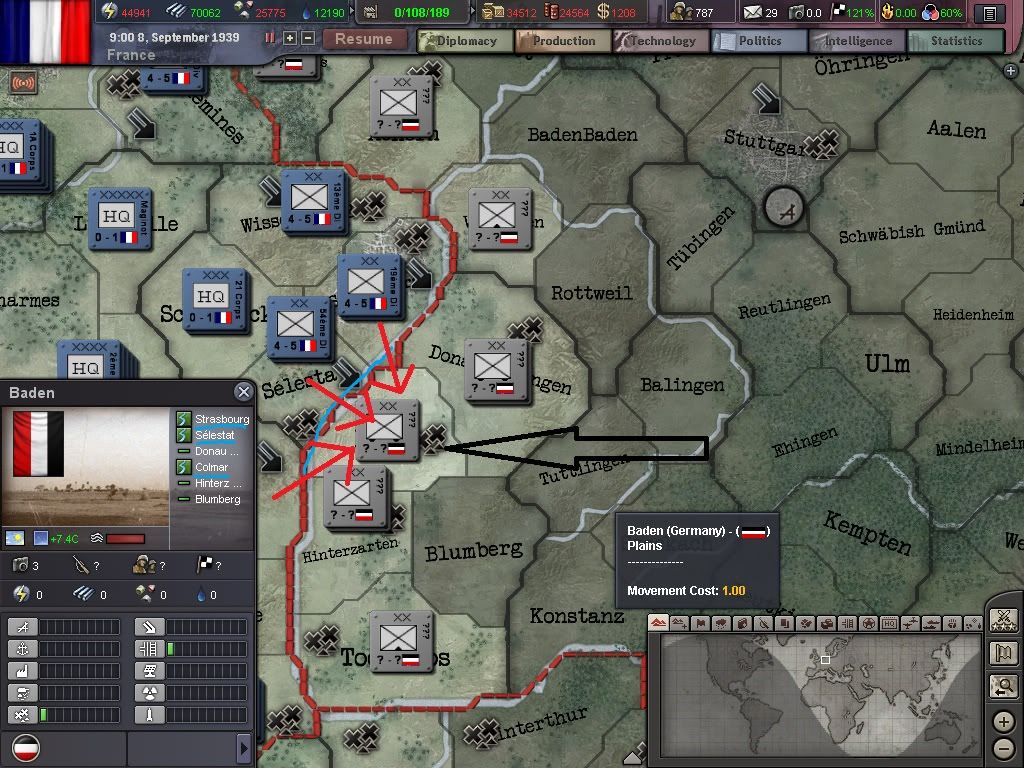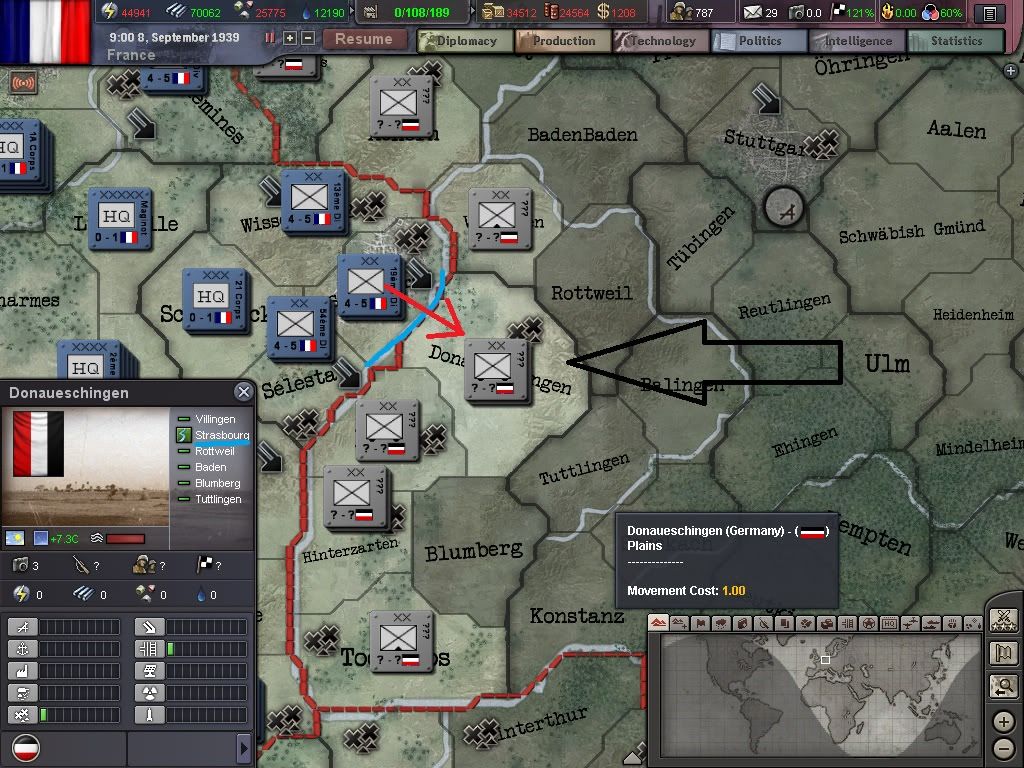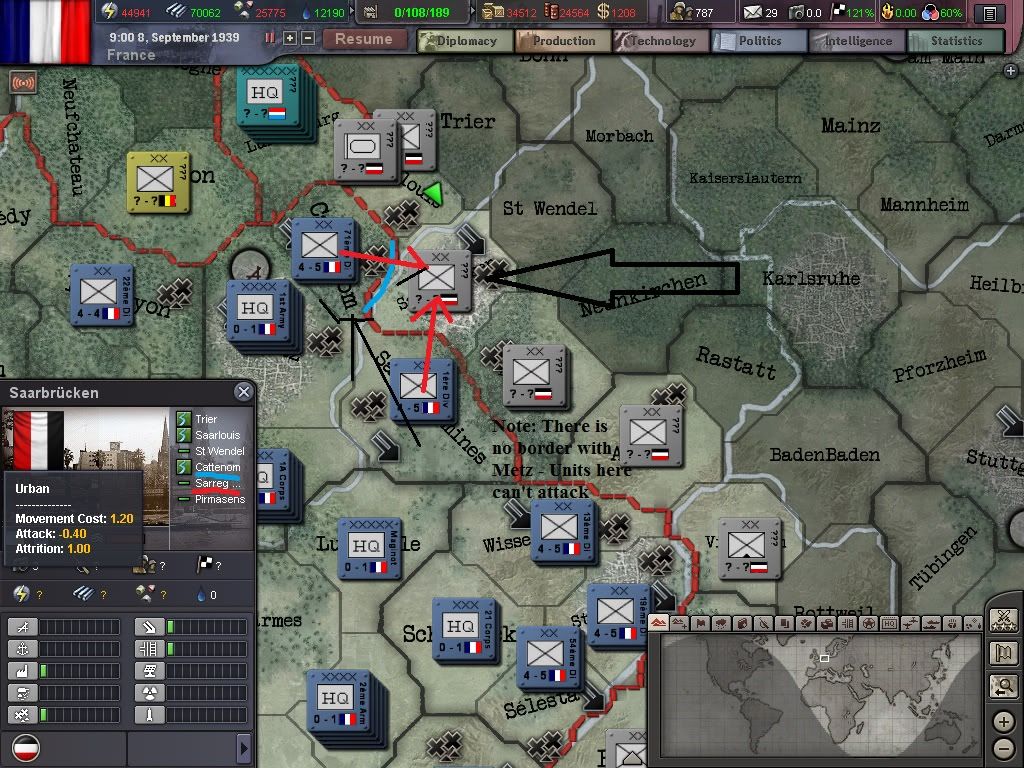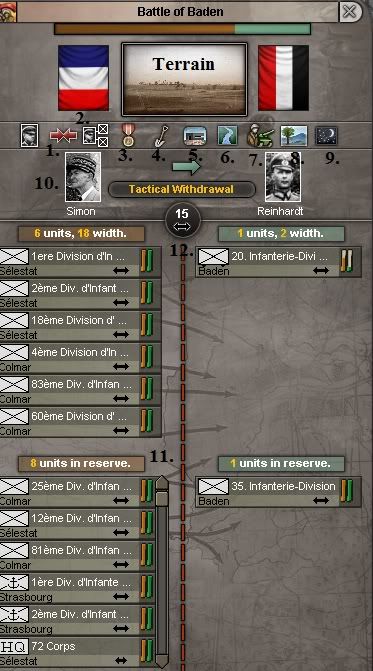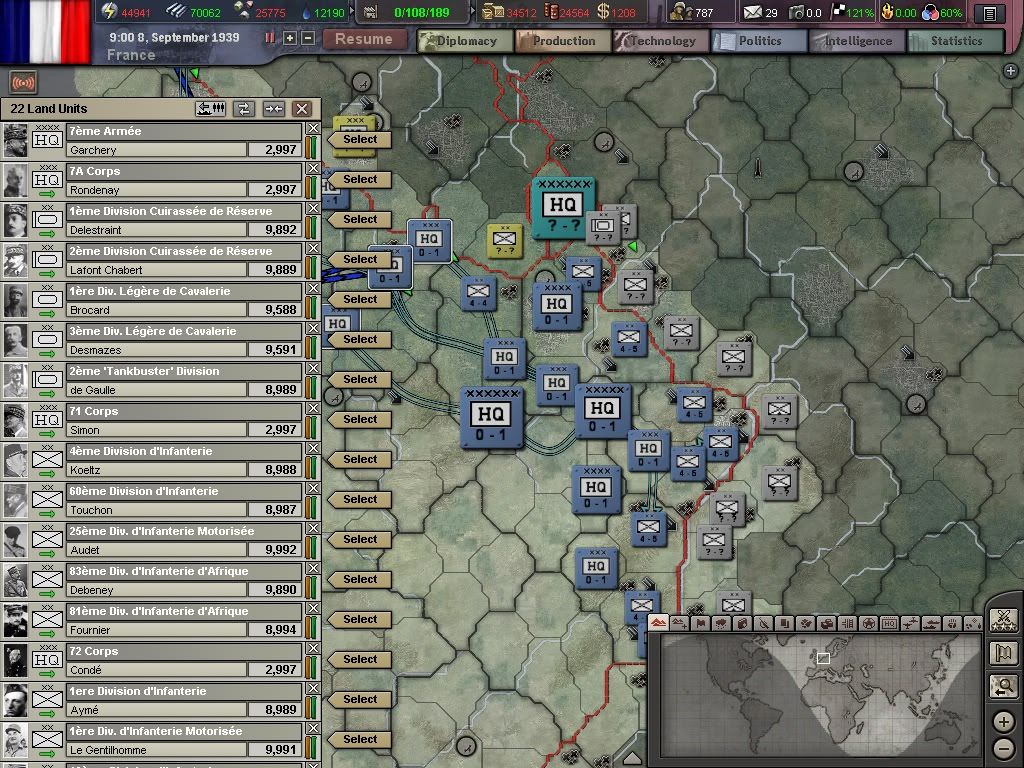Ground War Part 1: Tactical principles
This is as good a place as any to start the combat portion of the TutAARial. There are four provinces along the Maginot Line that the Germans have only 1 division protecting. Hopefully, by the time our reserves are all mobilized and we can bring elements of Paris HQ into the mix. We won’t have enough resources to break through the German lines with the troops we have here, as breaking through these fortified provinces is extremely difficult.
What we need to do is engage ALL of the German provinces along the Maginot Line in order to keep the Germans pinned down. These are called “pinning” attacks or engagements. By pinning down the Germans, they won’t be able to reinforce the more vulnerable provinces. Even though we probably won’t come close to winning any of these pinning actions, we win by keeping reinforcements out of action long enough for our troops to break through and cause havoc behind the German lines, where we don’t expect there to be as much resistance . . . at least not yet (until they figure out what we’re doing and respond).
You should also notice where troops are moving. Those that are moving are particularly vulnerable because they won’t get the “entrenchment” bonus. This is a bonus (1% a day for up to 10 days) to defending units that have been in place (and thus been able to prepare their positions). If you see units moving around on the other side of the line, this is a good opportunity to attack without having to give up the bonus.
When looking for places to make our breakthrough(s), there are a few things we’re looking for.
1. Forts. We’d rather not attack a province with a fort. Unfortunately, there aren’t any along the German border with France.
2. Terrain. We’re looking for the flattest, least obstructed terrain we can find. Cities, forests, woods, mountains, hills and rivers all give penalties when attacking. Certain units have smaller penalties in some terrain. Marines obviously have an easier time attacking over rivers and from ships, and the engineers that we’ve attached to the Marine divisions also further reduce the penalties for attacking over rivers. Mountain infantry obviously do better in the mountains and hills. Armoured and Mechanized/Motorized divisions do worse in forests and woods, as well as urban environments.
In almost any other terrain other than plains, the infantryman is king. If you’re looking for the easiest path to break through with armoured divisions, look for the plains.
3. Provinces that can be attacked from multiple directions/provinces. The more provinces that you can direct your attack from, the higher bonuses you’re going to get for multiple attacks, and you’ll also be allowed to stack more units into the battle (more on stacking later).
This is a good place to discuss the concept of Combat Width. Every combat unit has a certain width. Usually an infantry brigade has a width of one, and an armoured brigade has a width of two. Support brigades have a width of zero. Our standard infantry brigade is 3 infantry and 1 artillery, with a combat width of 3. The way the game works is that when there is one province attacking one other one, there is an available combat width of 10. You can keep adding divisions until the combat width is EXCEEDED. Therefore, we would be able to get 4 of our standard infantry divisions (we stack 3 divisions for a width of 9, which lets us get one more in, to bring our width of 12). Every extra province that you attack from adds a width of 5. Therefore, we’d be able to get 6 infantry divisions into a 2 province attack. (Combat Width of 15 – since 5 infantry divisions equals a width of 15 it hasn’t exceeded the width yet, we can still get one more in).
We also need to keep in mind the stacking penalty. Every unit above 5 in a province, either attacking or defending, gives a stacking penalty. You can reduce this penalty with a high level general as the Theatre HQ commander. This stacking penalty means that even if you have the combat width to put 6 or more divisions into combat, you’ll still be penalized for having that many divisions attacking from a single province. This also comes into play when you’re defending! If you have more than 5 divisions in a province and you’re being attacked, you’ll get a stacking penalty.
Let’s look at the pros and cons of attacking some of the provinces along our border with Germany. Also notice, that since we don’t have any radar deployed, we can only see the number of divisions in the province directly adjacent to our border. If we had radar (which helps air units as well), we’d be able to “see” farther into enemy territory. The other way to get better intelligence on enemy units is using your planes on attacking missions. I’ll demonstrate this later.
1: Todtmoos.
There is only 1 german division stationed there and there are two provinces that we can attack from. Also on the plus side is that the province terrain is plains, and the division is a mountain division. On the negative, there is a river blocking our path.
2: Hinzergarten.
2 German divisions here, but all other parameters are the same as Todtmoos, including the river.
3: Baden.
This is a plains province, has one has only 1 defender, and can be attacked from 3 provinces, although all three have a river border.
4: Donaueschingen.
While a plains province, there’s a river, 2 defenders, and a fort (standard for this region). Also on the downside, is that our attackers from Strasbourg are vulnerable to attack from 3 provinces.
5: Villingen.
Plains, 1 defender, can attack from 2 provinces, have to cross rivers.
6: Achern.
We don’t have to cross a river to attack, and there’s only one defender, but we can only attack from one province.
7: Pirmasens: Forest, 2 defenders, no river, can attack from 2 provinces.
8: Saarbrucken.
Urban, one defender, can attack from 2 provinces, only one of which has a river crossing. A quick note is that there is NO border with Metz, so we can't attack from there.
9: Saarlouis: at least 2 defenders, no river, can only attack from 1 province.
From this analysis, the best places to make a breakthrough will be Todtmoos, Baden, and Villingen. We will concentrate our forces in those three provinces, while attacking at the rest of the 9 provinces along the border to pin the German forces. Keep in mind that only the units under attack will be pinned while they’re fighting, which means that if Germany brings reinforcements from other provinces further east and north than the ones we’re attacking, there’s nothing to stop them.
Let’s talk about the combat mechanics a little. While you can get more information about detailed mathematical models that the game uses at the Wiki, or the strategy guides, let’s look at the Combat window to see what’s going on.
Clearly, we have a numerical advantage. but there's more to it than that. Each little point that is displayed has been given a number. There are other pieces of information that you can find out by mousing over certain things, like the general's picture (will give you his skill, experience and traits). If you mouse over a division, a tool tip will come up and give you all of the multipliers being factored in, like division combat experience, general experience and skill, terrain penalties, and a multitude of other things! In our screen, here's what we see.
1. Multiple fronts - this indicates that there's action from more than one front.
2. Stacking Penalty. Yes, we're getting a stacking penalty. More than 5 divisions from 1 province incurs a stacking penalty.
3. Indicates that Experience is a factor (I actually forget what this indicates at the moment, but I'll check it and edit!)
3. Entrenchment - this shows that the defending units have been immobile for at least one day and have "dug in".
5. Fortress - shows that there's a land fort.
6. River crossing - nuff said.
7. Combined arms bonus - shows that at least one unit is getting the combined arms bonus.
8. Terrain - indicates that terrain is a factor.
9. Night - it's night time, and unless you have the "night-fighting equipment" tech, both sides are penalized.
10. This is your highest level general involved in the combat. He's the one who's seen as the "leader" of all the troops, while individual divisions still get bonuses from their own leaders.
11. Units in reserve. These units aren't fighting. They'll have the possibility to reinforce (move up to the top) every round of fighting (every hour) depending on a number of factors. They only do this if there's available combat width. Clearly, the Germans in this example have a greater chance of reinforcing from reserves!
12. Combat width. This is 15 in our case because we're attacking from 2 provinces. If you look at our units - we have 6 units attacking and 18 width. Remember what I said, you can keep adding units as long as the combat width isn't exceeded. In this case, each infantry division has a width of 3 (1 for each brigade -- artillery and other support brigades don't take up combat width). 5 X 3 is 15, and since we haven't exceeded the width of 15 yet, we can add one more division for a final combat width of 18.
There's one final thing to discuss and that's the "Tactical Withdrawal" event just above combat width. The reason that the Germans' 35. Infanterie-Division is in reserve is probably that it has had the "tactical withdrawal" event, where a unit withdraws for a time. Various events occur, and are mostly randomly determined, but there are techs in the "doctrine" section that can increase likelihood of certain favourable events happening.
Needless to say, this plan is a big gamble. There are two things that we have to wait for. The first is our troops to fully mobilize. Right now most of our divisions are still about 300 troops short of fully mobilized. An combat brigade will have 3000 troops and a support brigade has 1000.
The second thing is that we need to wait for more of our forces from the 1st Army Group to arrive to do most of the dirty work.
While our Maginot line troops are adequate to defend against a German attack (and deter an attack), they’re not going to be nearly enough to break through these heavily fortified provinces. Even though it might seem like we could win the battle with even 3 or 4 divisions attacking, in reality, we’d probably need 8-10 in each province that we’re attacking, plus some air support. We’re going to have to throw the fighters and Tactical Bombers that we have at the Germans to help things.
We’re going to actually use the German philosophy of Schwerpunkt against them. This is the idea of applying a decisive amount of force at the decisive time. It is also imperative that we achieve our breakthroughs as quickly as possible in order to push our fast moving armour through before more units are able to be brought from the north and east to engage in the battle and keep us bogged down at the fortress line. We also need to achieve operational surprise by not even coming close to attacking or sending fighters and bombers overhead until the moment we attack all across the front. If we can mass an overwhelming amount of force at our chosen points, we should be able to achieve a breakthrough fast enough.
Also, one of the most important things to do before we launch an attack is to have a plan for what the ultimate goal is. To achieve victory in HOI3, you must capture a percentage of a country’s Victory Points that exceeds the country’s national unity.
(VP map mode)
Because Germany’s national unity is 90%, we’re going to have to take almost all of Germany’s Victory Points. We also need to make sure that we can defend what we hold. Our Plan could be to sweep through the south (hopefully breaking through at several points), and then pushing north as far as the North Sea in order to trap the German divisions and eliminate them. The outside divisions will dig in and prepare for the response from the Eastern Front with Poland. Hopefully our British allies will help us out! In actuality, this is probably too much to hope for, but we’ll give it a go. However, our plan is really to hopefully distract the Germans enough to help out Poland, and maybe take and hold as much territory as possible.
Operationally, I will bring the 7th army as a main assault force with its 10 infantry and 5 armoured divisions. I will also detach the 1st Marine corps (2 divisions) from the 3rd army and attach it to the 7th. The third army will serve as a reserve force with its 9 infantry divisions. In terms of extra reserve forces, the Maginot Line HQ has the 1st Army with 7 infantry divisions and 3 armoured divisions, and the 2nd Army has 12 infantry divisions and 3 armoured divisions. The infantry will do the dirty work in the trenches, and the armour will exploit our breakthroughs.


